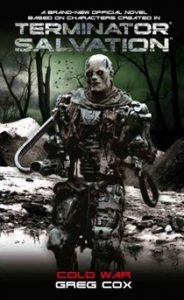Greg Cox’s “Cold War” (October 2009) is the first spinoff material to come out after “Terminator Salvation,” but it’s actually another prequel story, like “From the Ashes” and “Sand in the Gears.” The major tie-in to the film is the backstory of General Losenko; his story in the wake of J-Day alternates chapters with that of an Alaskan Resistance group right before “Salvation.”
A good mix of action and characterization, “Cold War” is a brisk page-turner. It gives us insight into how the Resistance is formed from the survivors of various militaries around the world, the politics that go into choosing U.S. General Ashdown as the leader, and the fact that Ashdown views civilian militias as inferior to the top military minds. Just as John’s group has to prove itself in “From the Ashes” to be invited into the Resistance proper, Molly’s group in Alaska is out to prove itself with an attack on a Skynet train.
I enjoyed the book for the way it gives depth to Losenko and Ashdown, and how it shows the brutality – yet also the stark beauty — of life in Alaska during the war against the machines. (Cox is no doubt familiar with the terrain, as he dedicates the book to his relatives in the state.) But after three “Salvation” prequels, I’m ready for the story to move beyond the events of the movie.
CHARACTERS
Sarah Connor: Not in this story, as she had died in 1997 of cancer.
John Connor: Not in this story, although he is mentioned by Molly and other Resistance members as an inspiring figure due to his radio broadcasts. In the wake of J-Day, General Ashdown dismissively says John is “just a voice” (chapter 15).
Kyle Reese: Not in this story.
General Losenko: The captain of a Russian submarine, he follows Moscow’s orders to retaliate against the U.S. for the Judgment Day strikes. His missiles strike Alaska, and among the victims is General Ashdown’s son. Losenko serves aboard Ashdown’s USS Wilmington from shortly after J-Day through the events of “Terminator Salvation.”
General Ashdown: The top American military survivor, he organizes the Resistance in an “official” military sense, contrasting with John’s assertion that everyone is the Resistance. Ashdown chooses Losenko as his second-in-command despite the fact that Losenko’s missiles killed his son. Since Losenko and Ashdown don’t agree on the value of civilian militias, Ashdown correctly sees it as a good political move to have Losenko at his side. Interestingly, Ashdown admits he was a proponent of the Skynet initiative (17). However, he apparently wasn’t that big of a mover and shaker, as he’s not mentioned in any of the “Terminator 3” materials. Ashdown is known as “Old Ironsides,” which is no doubt Cox’s nod to the actor who portrays Ashdown in “Salvation,” Michael Ironside.
Ivanov: Losenko’s second in command, he doesn’t absolve the Americans for J-Day just because it was an accident.
Molly Kookesh: A native Alaskan and former park ranger, she leads a Resistance cell in the rugged wilderness in 2018. Like John Connor, she struggles to be taken seriously by Resistance Command.
Geir Svenson: Molly’s lover and the only pilot in the Alaska cell.
TERMINATORS
T-600s: The classic endoskeleton with rubbery skin. They are vulnerable in the backs of their necks, their shoulder joints and their backs. They weigh about 800 pounds. Cox shows us some scenes from a T-600’s point of view, which is always fun.
T-70s: Molly and Geir fought a bunch of T-70s on their “first date” (4). We get no further information about this model, but the Terminator Wiki says this is the first Terminator in humanoid form.
T-1s: The original mini-tank Terminators, as introduced in “T3.” Losenko loses several crew members in a battle against these robots after docking at the ruined Russian port of Murmansk. They are known to have vulnerable necks (9).
Snowminators: Like the Moto-Terminators from “Salvation,” except in the form of snowmobiles rather than motorcycles (22). (Yes, “Snowminators” is the word Cox uses.)
CONTINUITY AND CONTRADICTIONS
If we’re to take Cox’s book at its word, Losenko’s backstory takes place in 2003, with Judgment Day occurring on July 25, 2003. This is no doubt based the “Terminator 3: Rise of the Machines” novelization, which places the action in that year (Cox lists David Hagberg’s book in his bibliography). Most other sources, including the Terminator Wiki, place “T3” in 2004 (I don’t know why the adjustment was made after the novelization’s publication). Since everything else about the book lines up with the “T3″/”Salvation” timeline, I’m going to write off the 2003 date as a mistake.
The Alaskan cell’s adventures are set in 2018, just prior to the events of “Salvation.” It takes place after “Sand in the Gears” and before/concurrently with “From the Ashes.”
Alaska, home to Molly’s Resistance cell, is also featured in S.M. Stirling’s novel “The Future War,” on the “T2” timeline. And there is a Resistance base in the Yukon from which Ivanov flies a fighter jet to help Molly’s group (22). Western Canada is also a significant setting in “The Future War.”
A Russian submarine is also featured in the comic book “Hunters and Killers,” on Dark Horse’s “T1” timeline, and in Now Comics’ 2031 Future War. In those stories, the U.S. and the Russians work together, but they are not united under the wider Command umbrella, as they are in the “Salvation” timeline.
Just as the Russians have their Resistance headquarters on a submarine in “Hunters and Killers,” Ashdown considers land too dangerous, and the USS Wilmington becomes Resistance Command (19).
In “Hunters and Killers,” Russia features significant Skynet (or “Mir,” as it’s known in that comic) production facilities. In the 2029 of “H&K,” Skynet cranks out Stealth Terminators (better than normal Infiltrators, they can mimic specific people). In the 2003 of “Cold War,” T-70s are produced at a factory downriver from Murmansk (11).
After J-Day, there are essentially four types of humans: Those who fight back (either formally or informally with the Resistance), those who collaborate with Skynet (often because Skynet threatens their loves ones) (15), those who are slaves (11) and those who are still living their lives (albeit in more bleak fashion) (19). The heroes of “Cold War” have to fight off some collaborators – who are a less-organized version of the Luddites in “Future War” – and we see that early production of Terminators and other Skynet tech is done in part by human slaves.
Some fans have wondered why some Skynet facilities – for instance, Skynet Central in “Salvation” — seem to be rather human-friendly (with lighting and audible alarms and so forth). Skynet’s use of slaves and collaborators, at least early in the war, might explain this.
Molly and many of the Alaskans refer to Terminators as “metal” (4). Cox might have been influenced by “The Sarah Connor Chronicles,” where Derek Reese in particular favors that term. Some theorize it came about because the show’s licensing agreement only allowed so many uses of the word “Terminator.”
Consistent with the “T3″/”Salvation” timeline, Skynet’s designs spring from U.S. military blueprints, including an aerial drone that is like a small version of a Hunter-Killer (18).
Ashdown organizes the military leaders for a summit at the Galapagos Islands off the coast of Ecuador (17). South America features heavily in the saga, particularly in the Stirling and Blackford novels on alternate “T2” timelines, where Sarah and John lay low and hone their fighting skills after the events of the second movie.
Molly and Losenko communicate via what is essentially Skype (19). In most “Terminator” lore, communications are audio only.
Losenko mentions the Niger mission to take out a Skynet mine in “Sand in the Gears.” Similarly, Molly is hoping to procure uranium from the Skynet train, although she ends up destroying it (which is also a victory, as the uranium would be used for the nuclear cells that power T-800s). And Ashdown references General Olsen’s mission in “From the Ashes” (20).
Rumors that a shut-off code can be found at an underground Skynet facility near Los Angeles lead Ashdown to tap General Olsen — and, by extension, John — for that mission (epilogue), which kicks off the events of “Salvation.”
TIMELINES AND TIME TRAVEL
There is no time travel, nor any discussions of timelines, in “Cold War.”


